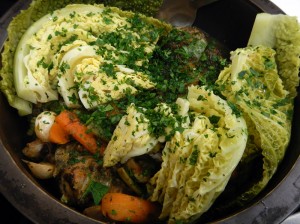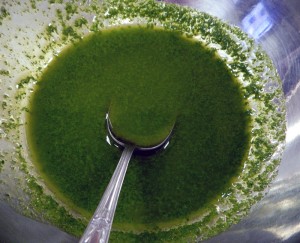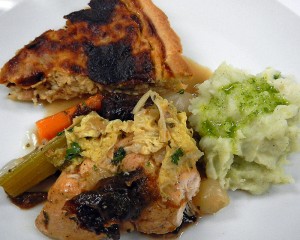Although the Alsace is a province of France, it is right on the border with Germany, and the food and wine has been heavily influenced by the Bavarians. One blog described it as ‘Germany with a French accent,’ and that was certainly true when I was in there many years ago (1978).
The place that I was staying at had a fixed prix meal that included sauerkraut & sausage. Not being at all fond of cabbage, I was dreading it. But the French version of sauerkraut was a delicate ‘choucroute‘, sauteed in butter with celery seeds sprinkled throughout. And the French sausages were vastly superior to any German sausages I had eaten, not at all greasy and heavy. It was one of those extraordinary dishes that stay in your memories forever.
I guess one has to put up with cabbage if one is going to go ‘Alsatian’. So here goes with the main dish of the evening: Chicken & Cabbage & Prunes in Reisling. Described as French comfort food by one student, another added “I could eat that every day.”
- To make the peeling of the pearl onions easier they were soaked in hot water for a few minutes beforehand.
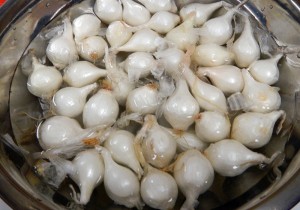
- The peeled pearl onions, carrots and celery were lightly sautéed in olive oil.
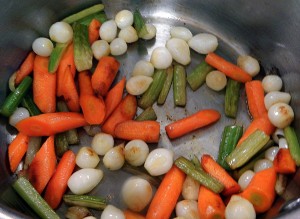
- A whole chicken was cut up into eight pieces (or in our case, Chef Eric demonstrated how to properly cut up the first half of the chicken, and I managed to massacre the second half.)
- The carcass was thrown into a pot of water with leftover herbs in order to make the stock
- The chicken pieces were browned and then added to the bed of vegetables along with all the other ingredients including prunes, herbs, wine and cabbage.
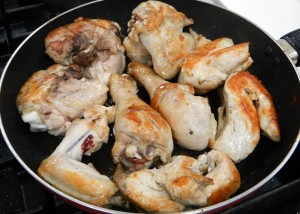
In the meantime the potatoes were cooked, mashed and drizzled with a chive and parsley oil.
The wine Chef Eric selected to go with the entree was an Alsace ‘Grand Cru’, an extraordinary Reisling. Unlike German Reislings, this is not a sweet wine, and rates a ‘0’ on the sweetness scale.
Dessert was another experience overload. First we had a Kirsch Soufflé…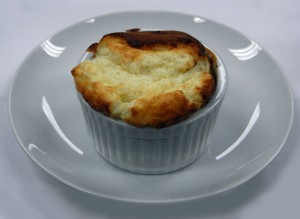
…served with a Muscat. My wine tasting notes from 1978 say: ‘Muscat *** -dry but grapey, with a fruity taste that made it almost sweet.’ My new tasting notes as of 2012 say: ‘one of the very few ‘dry’ muscats; distinctly grapey taste that remind me of Liz’s grapes from her garden, bearing no resemblance whatsoever to the grapes you buy in the supermarket.’ Chef Eric added that 2010 was a very good year and the wine typically can be aged 2-5 years.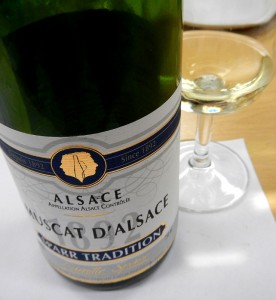
Then came the Kronenburg 1664 Beer Sorbet with Läckerli Cookies. The Beer Sorbet is simply beer and sugar, put into an ice cream maker. The Läckerli Cookies are not so simple, with tons of ingredients. The green bits are candied angelica.
With this dessert, a Kronenburg 1664 Flavoured Wheat Beer, with ‘peachy’ overtones, was the drink of choice.
Alsatian Cooking Class 2, Part 1 featuring Sauerkraut Soup with Smoked Sausage, tarte flambée or ‘Flammekueche’ , a meaty stew called ‘Baeckenofe‘ served with Sweet and Sour Cabbage and of course, lots more Alsatian wines!

